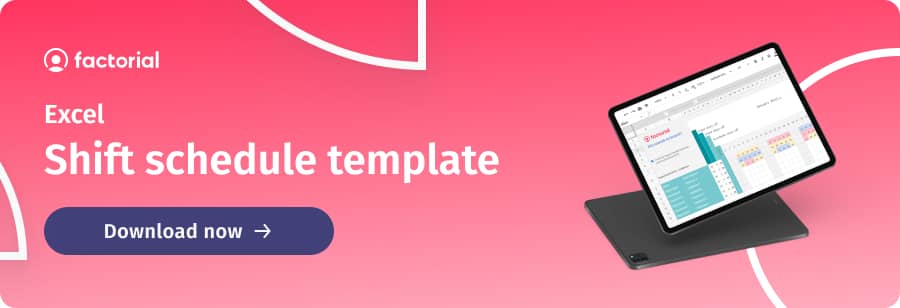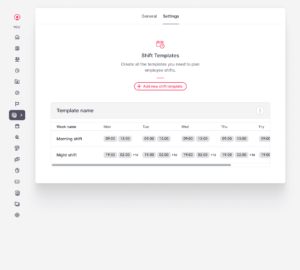Good employee scheduling leads to smooth sailing. Maintaining a balanced schedule helps businesses keep the floor covered, customers happy, and goals in sight. Shift managers who have a lot to worry about rely on a shift scheduler to keep their employee calendar in tip-top shape.
In this post, we’ll cover different shift schedules and the software that can help you streamline your planning process and run a tight ship. Whether you’re looking to switch to a shift work system or simply looking for ways to streamline the one you have in place, here we’ll cover everything you need to know about shift management.
Benefits of a Shift System
Considerations for Implementing Shifts
Tips for Improving Shift Management
6 Types of Shift Work Schedules
Are You Still Using a Shift Schedule Template?
Tools to Manage Shifts
What is shift management software?
Free Shift Management Software
More shift management tips
Employee Scheduling Software ✅
Benefits of Shift Management
Good employee shift management helps employers to take advantage of all the benefits of shift work. Keeping track of employee hours with an employee calendar or shift scheduler can save both time and headache. Here are some ways that using tools to manage shifts can work for you:
Shifts Support Employee Flexibility
These days, employees value flexibility. Working shifts may allow employees to better manage their time. If an employee has childcare responsibilities, they may want to work early shifts so that they can be available for their kids after school. University students might prefer an evening shift so that they can be in class in the mornings. Well-managed shifts can give employees with irregular schedules the ability to work full-time.
Shift Work May Lead to Company Growth
Having employees work in shifts means the business can stay open for longer and be well-staffed during peak hours. This means more time for productivity and can help growing businesses thrive.
Tailored Shifts Keep All Hours Covered
Shifts help businesses tailor staff numbers to their needs. For example, in one New York City bookstore, two employees come in for the opening shift at 10 am. Two more employees come in for each of the following three shifts: at 11 am, at 1 pm, and at 3 pm. This means that during the afternoon rush when the bookstore makes most of its sales for the day, there are eight employees on the floor ready to help customers. At 6 pm, the early-shift booksellers head home with the rest leaving at 7 pm and at 9 pm. In the last hour, when business is slow, there are only two employees left. This shift system maximizes efficiency and allows the bookstore to make the most of the peak hours while cutting costs when things are slow.
Considerations for Creating A Shift System
What shifts will support the business as it evolves? What works best for your employees? Creating a shift management system is a balancing act that requires careful thought.
Schedule Consistency
When designing a shift schedule, employers must consider the shift timing. Will there be a fixed schedule, where employees come in at the same time every day? Or will an employee begin work at different hours on different days, but keep the same schedule week-to-week (i.e. working 10-6 Mondays and Wednesdays and 11-7 Tuesdays and Thursdays). Will employees need to rotate shifts? That might mean that employees may take the early shift for a few weeks and then the later shift for a few weeks. It’s important to remember that most employees prefer some kind of consistency. The key is to make the schedule as regular as possible even when the hours are irregular.
Clocking in & Out
How will employees clock in and out? If your business is still doing things the old-fashioned way with a punch-card system, it may be time for an update. With a shift management app, employees will be able to clock in and out directly from their phones. This is more convenient for employees and helps ensure that they are fairly paid for their time. The record automatically generated by the digital time clock can also help to protect employers from disputes down the line.
Backup Plan for Unexpected Absences
Always expect the unexpected! Smart employers managing shifts will make sure they have a plan for unplanned absences. Employees may need last-minute time-off for sick days, heavy traffic, etc. In addition to having guidelines about how employees can swap shifts and request time-off in advance, businesses also need plans for last-minute replacements. In industries where it is vital to always have a full staff, employers may ask employees to be on-call one day a week, ready to come in if something should come up. They can offer bonus pay to workers called in at the last minute.
Tips for Optimizing Your Shift Management System
If you already have a shift management system up and running, we have some tips to make it even better.
Avoid Rotating Shifts
As we already mentioned, most employees value schedule consistency. It makes it easier for them to plan the rest of their lives and is better for their circadian rhythms. If you can avoid rotating shifts, you should. If there is no way around it, try to make the rotations as gradual as possible. That means it’s a bad idea to switch someone from the morning shift to the night shift. Instead, move them from the morning shift to the afternoon shift. Tired workers aren’t effective. It will also help to have longer rotations so that employees spend a few weeks on one shift rather than a few days.
Use Visual Shift Management Tools for Scheduling
Having a visual representation of the schedule is helpful to both employees and employers. Managers can see any unnecessary overlaps or holes, and employees can see clearly how their week will look. Some professionals may opt for a downloadable shift schedule template to stay on top of employee hours. Others may choose to cut time and hassle with shift management software. Shift management software can help create a calendar everyone enjoys using. Unlike the pesky paper scheduled in the back room, it also updates automatically so that everyone is aware of changes.
Identify Trends & Plan for the Future
Whether using an employee schedule template or software, proactive managers can keep track of trends in the schedule and use the information to plan for the future. Got an employee who always comes in late to the morning shift? Maybe it’s time to move them to the afternoon or have a serious discussion. Do all your employees scramble to swap shifts during the holidays? Come up with a clear system for swaps and trades. Maybe even consider getting seasonal employees to avoid being short-staffed with the business boom! Take advantage of software to gain valuable insight into how your business works and how it can be improved.

6 Types of Shift Work Schedules
Shift work schedules are common in industries such as restaurants and bars, hospitality, public service, manufacturing, supply chain, retail, medicine, and more. Each industry may require different shift work schedules. With shift schedules 24/7 coverage is possible. Find out which shift work schedule best fits your business.
Fixed Shift Schedules
With a fixed shift work schedule, the same crew always works the same shift. For example, a server may work the dinner shift four times a week, coming in at 4 to leave by 11. Many employees prefer fixed shift schedules because their regularity makes it easier to plan around.
Split Shift Schedules
In a split shift, a person’s workday is split into two or more parts. Importantly, this does not refer to a break for a worker to eat or rest. A shift is considered “split” if, for example, an employee works from 7 to 11, goes off the clock, and then returns to work from 3 to 6. As you might imagine, this shift type is no favorite of employees and should be avoided if you want to retain quality staff.
Overtime Shift Schedules
It is not ideal to have employees clocking overtime, but in certain situations, employees may end up working more hours than a typical shift. It’s important to carefully track hours to make sure overtime pay is compliant with the federal time-and-a-half policy as well as local regulations. Additionally, keep a close eye on employees to make sure they aren’t burning out.
Rotating Shift Schedules
With rotating shifts, employees change shifts. For example, a customer service representative may work the early morning shift for six weeks, and then the later evening shift for six weeks. Employers opt for a longer shift rotation schedule so that employees can have more stability, but employees prefer fixed schedules. Rotating shift schedules 12-hour shifts can be especially brutal.
On-Call Shifts
With on-call shift work schedules, an employee is not scheduled to come into the workplace, but they need to be prepared to come in if someone should call out. This practice is more common in industries where being understaffed can have detrimental effects. Employees may take turns being “on-call.”
No-Schedule Shifts
In this system, managers schedule shifts on an ad–hoc basis to fill in gaps as they go. There is little or no regularity in the scheduling, with an employee receiving certain shifts one week and totally different ones the next. This may be common in sectors with high turnover where it is difficult to plan for regular shifts.
Read another article for more work shift schedule examples to find the best one for your business.
Are You Still Using a Shift Schedule Template?
Some employers use a shift schedule excel template to keep things organized. This can lead to irregularities and confusion that ultimately cost the business money and hurt employee morale. Using a shift schedule template works for a while, but doesn’t provide the organizational tools necessary for a growing business.
If your business suffers from scheduling issues such as insufficient coverage, high turnover, and disorganization, it may be time to try automation.
It’s time to switch to digital solutions
Shift Management Tools
Shift management software can provide an elegant solution to any of your shift-related problems. Simplify and streamline your shift management to maximize efficiency.
Easily Manage and Assign Employee Shifts
Make employee scheduling easy with a highly visual calendar as part of your shift management tool. Shifts can be repeated daily, weekly, or over a longer time period. The software will make it easy to spot holes and will also automatically notify managers of any scheduling conflicts. Employees can check their schedule at any time with a shift management application and make any necessary requests directly through the software.
Integration with Time Off Systems
Efficiently handle employee absences with automated time-off requests. Employers can manage who is on vacation, on sick or medical leave, and who is available for scheduling on one portal.
Run Reports to See Trends
With software, employers can take advantage of the data accumulated to do custom HR reporting. They can create visual representations of hours scheduled versus hours worked and other information.
Shift Management Software Free with All Factorial Plans
If you are looking for a shift management solution, Factorial may be just what you are looking for. This shift management software is free with a subscription to Factorial’s comprehensive HR software. With shift management software, you will be able to balance shifts and have happier, more productive employees.
Manage Employee Shifts Easily Thanks to Factorial HR
What is shift management software?
Shift management software is a tool that allows you to keep track of employee hours and plan work schedules. Like many kinds of HR tech, and software for hr transformation, it helps to make time-consuming and tedious parts of shift management more automated.
For example, in companies where employees work in rotating shifts and alternate morning (1st shift), afternoon/evening (2nd shift), and overnight (3rd shift), it requires a lot of juggling to organize and plan out weekly hours. And when employees are sick or on vacation, the complications are tenfold. With shift scheduling software, managers can easily organize their teams and ensure that all shifts are covered.
Shift management with Factorial
Many think of shift management as a time-consuming activity, done with Excel, or even worse, pen and paper. This means that when managers need to make any additions or scheduling changes, everything needs to be done manually and one-by-one–an inefficient and painstaking task for anyone! With Factorial’s shift management software, the process is intuitive and changes can be made within seconds. Let’s take a look at some of the individual features that Factorial’s software has to offer.
Flexible shift planning
There are many situations in which it might be necessary to make last-minute scheduling changes. Perhaps your business is growing and you need to make changes to accommodate new team members. Or, perhaps you have a rotating schedule that makes it complicated, to say the least, to navigate everyone’s vacations and paid time off.
Factorial’s shift management software is perfect for agile teams and for making last-minute time-off adjustments. Unlike cookie-cutter, one-size-fits-all software, with Factorial, you have the flexibility to make scheduling decisions to better fit your operational and team needs.
When it comes to adding new shifts, you can opt to do so for individual employees or groups (such as by team or department), ensuring maximum flexibility and efficiency. Specifically, this feature allows you to:
- Add shifts for individual employees on a specific day
- Filter by teams, departments, or groups and add shifts for multiple employees on a specific day
- Add shifts for individual employees for an entire week
- Filter by teams, departments, or groups and add shifts for multiple employees on a specific week.
Assign shifts
After installing Factorial’s shift management software, you will need to create a database with members of your team. This process is very straightforward and intuitive, you’ll simply need to click on the three dots in the right-hand corner of the screen and then select “Add employees.”
From there, you´ll be able to assign employees shifts simply by clicking the “Assign shift button”, also located in the upper right-hand corner. This tool lets you choose between previously saved custom shifts, default shifts, and shift templates, giving you the freedom to assign employees existing shift schedules, or start from scratch. In a nutshell, you’ll have more scheduling options and fewer obstacles.
Manage overnight shifts
Keeping track of overnight shifts is easily done with Factorial’s “custom shifts” option. After clicking on this, simply set the hours for the shift and assign it to your employee(s).

Overnight shifts can be a real logistical nightmare for many managers. Not only is it difficult to keep track of rotations, but logging hours can also be an area of concern.
Factorial’s software takes into account these difficulties and eliminates the confusion of keeping track of employee hours. Automatically, all of the shift hours are recorded and organized by the day that the shift started.
Choose your shift management view
Depending on the type of business and the number of schedules that you are managing, you might need to get an overview of schedules for an entire month or zoom in to see what the calendar looks like for a given week. With Factorial, you can enjoy the best of both worlds and comfortably visualize schedules by week, four weeks, or by month.
You can easily flip from one view to another by clicking on the toggle menu on the left side of the screen (located above the employee list and next to the filter button).
*Note that for the four weeks or month view, shifts with extra details will appear with an orange dot. You can easily access information about the shifts or make edits by simply hovering the mouse over the shift and clicking the pencil icon.
Create and add various shift templates
Ideally, assigning shifts would be painless and require as little time as possible. Typing the same hours for employees week after week on an Excel sheet can be maddening and it’s probably not the best way to spend your time.
With Factorial you can create reusable templates that will save you some steps and hours of your day. Not to mention, it’s a much safer and more accurate way to organize. Working from templates reduces the number of typos and the margin for human error.
Creating new templates is a very straightforward process. From your main dashboard home page, click on the “Apps” section off to the right of the screen, then click on the “Shift Management App” option, and then click “Settings”. Or, even faster, select “Shifts” from the main dashboard and then click “Settings.”
From there, click the “Add a new shift button” in the center of the screen and name your new template (“morning shift”). All that’s left now is to assign the shift to the desired weeks and times. With this feature, you can also customize the working days and hours for each week. Perfect for organizing hours for teams with rotating turns.
More shift management tips
Now that we’ve provided you with a better idea about how Factorial’s shift scheduling software works, let’s talk management techniques. Here are some pointers for professionals about shift management communication, managing overnight shifts, last-minute changes, and more.
Tips for overnight shifts
Working the third or graveyard shifts is often not employees’ first choice. It interrupts the natural sleep cycle and usually presents other scheduling conflicts for employees. In order to compensate employees with positions that require overnight work, many managers choose to pay them extra, or what is called a “shift differential”. Additionally, you might want to schedule more frequent check-ins with employees who work overnight shifts and do everything possible to encourage employee wellness.
Communicate with your team
When it comes to managing employees’ schedules, especially if hours are irregular, communication is everything. While sending out employee shift schedules, keep it simple and stick to one channel. For example, sending out a monthly email with a company-wide Google calendar. You’ll want to be clear about who is working at what time and eliminate any potential sources of confusion, if possible.
To reduce last-minute scheduling changes and absenteeism, ask your team about their preferred working hours first. They will feel appreciative of the consideration and you will be able to plan more accurately.
Stay compliant with time-tracking laws
While rearranging and assigning shifts, you’ll want to ensure that all scheduling changes comply with Federal and State legal requirements. Otherwise, your business could suffer from employee turnover, workplace hostility, and even some hefty penalty fees.
To ensure compliance, make sure that you are familiarized with federal overtime and time-tracking laws under the Fair Labor Standards Act (FLSA). Additionally, take into account any extra state overtime and time-and-a-half laws that might apply to members of your team.
Once you’ve familiarized yourself with legal requirements, you’ll want to make sure that you have a way of keeping an accurate headcount report and record of employee timesheets. If you are still using excel, consider using a time and attendance template to stay organized. Otherwise, make sure that you have software that is capable of generating timesheet reports for employees.
Stay ahead of changes with the right software
Finding out who should work and when is complex enough. Let alone managing scheduling preferences and last-minute absences.
With the right software, you can stay ahead of the curve and prepare for when things don’t go as planned. You’ll have a “go-to” system in place so that if there are any shift adjustments that need to be made, you can make them instantly.
Also, certain all-in-one HR softwares, like Factorial, allows you to communicate important announcements to your team through an Employee Dashboard. That way, both you and your employees will be notified of important changes immediately.
While used in tandem with Factorial’s time-tracking feature, you can generate reports and keep clear records of employee hours. No more searching through spreadsheets and risking legal compliance, with Factorial, you’ll have everything under your fingertips and running smoothly.
Read our article on the 9 best shift scheduling software for more information.






Nice blog. Thanks for sharing it.
Glad you enjoyed all the information we shared.